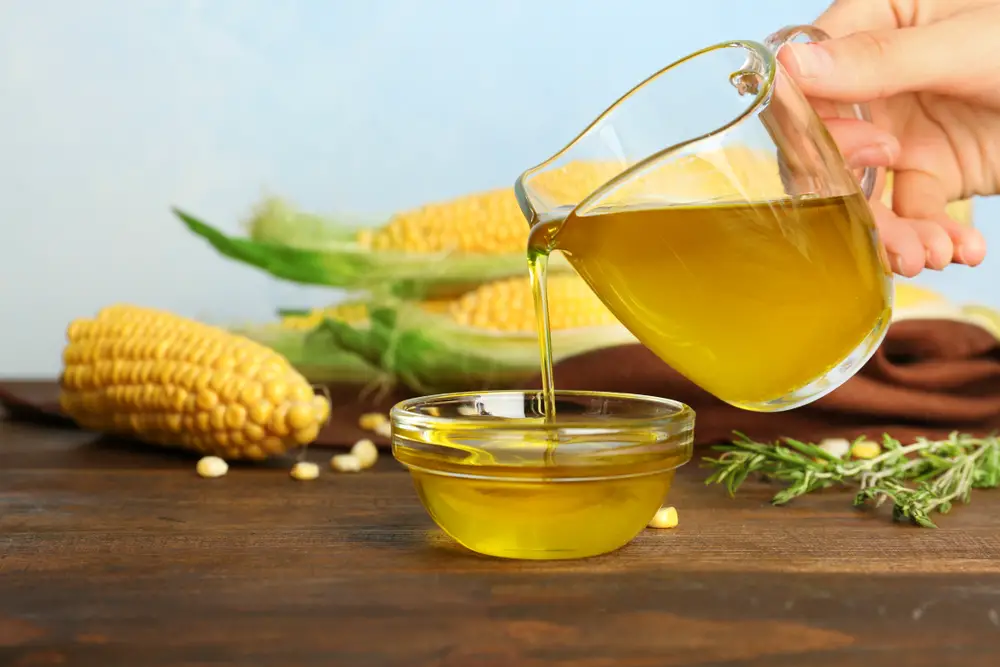Choosing the right cooking oil can make a difference not only in taste but also in the nutritional value of your meals. Two popular options that have sparked some debate among health-conscious cooks are corn oil and canola oil.
Understanding their origins, composition, and potential health impacts can help you make an informed decision about which oil is best for your culinary needs.
Corn oil is a widely used cooking oil that is extracted from the germ of corn kernels. It has a mild, slightly nutty flavour that is well suited for frying and baking. On the other hand, canola oil is derived from the canola plant, an edible cultivar of the rapeseed plant.
The name canola pays homage to the Canadian origins of the crop and its unique properties. With a relatively neutral taste and a higher smoke point compared to corn oil, canola oil is often favoured for its versatility in the kitchen.
Both oils have their merits and, depending on the specific application, they can offer unique benefits in terms of taste and nutritional value.
With the variety of cooking oils available today, understanding the differences between corn oil and canola oil will enable you to make an educated choice that suits your personal preferences and nutritional requirements.
Understanding Corn Oil and Canola Oil
Corn oil and canola oil are two popular types of cooking oils used in kitchens around the world.
Each of these oils has its unique characteristics, making them suitable for different cooking needs. In this section, we will take a closer look at what sets them apart.
Corn oil is extracted from the germ of corn (maize) kernels. Maize is a significant crop in the United States, making corn oil a widely available and affordable option for many households.
The oil has a relatively high smoke point, which makes it suitable for high-temperature cooking, such as frying and sautéing. Its mild yet distinctive taste and golden yellow colour are some of its signature attributes.
On the other hand, canola oil is derived from the seeds of an edible version of the rapeseed plant, which Canadian scientists developed. The name “canola” comes from combining the words “Canada” and “ola,” meaning oil.
The oil is known for its neutral flavour, making it an ideal choice for recipes where the taste of the oil should not overpower the other ingredients.
When looking at the nutritional content, both corn oil and canola oil have their advantages. Canola oil is generally considered healthier due to its lower saturated fat content and higher proportion of omega-3 fatty acids. Meanwhile, corn oil contains more omega-6 fatty acids and has a higher amount of vitamin E.
Another factor in comparing these two oils is their versatility. While they share similarities in cooking applications due to comparable smoke points, canola oil’s neutral flavour makes it more suitable for use in a wider range of dishes, including baked goods and salad dressings.
Corn oil, with its stronger flavour, may be more appropriate for recipes where a touch of this distinct taste would enhance the overall dish.
In conclusion, both corn oil and canola oil have their unique characteristics and benefits, with one not necessarily being better than the other. Their suitability for various culinary applications depends on factors such as the desired flavour profile, nutritional considerations, and cooking methods.
As a result, having both of these versatile vegetable oils in your kitchen ensures you are well-prepared to create an array of delicious dishes.
Nutritional Profiles of Corn Oil and Canola Oil
Corn oil and canola oil are popular choices for cooking due to their versatility and affordability. Despite their similarities, they possess distinctive nutritional profiles, varying in their content of various nutrients and fatty acids.
Corn Oil: Extracted from corn kernels, corn oil contains a substantial amount of polyunsaturated fats, particularly omega-6 fatty acids. Its fatty acid composition is approximately 13% saturated fats, 28% monounsaturated fats, and 59% polyunsaturated fats.
Corn oil is also a rich source of phytosterols, which can help reduce cholesterol levels.
It provides moderate amounts of vitamins E and K and lacks omega-3 fatty acids. Corn oil contains roughly 120 calories per tablespoon.
Canola Oil: Derived from the rapeseed plant, canola oil boasts a more balanced fatty acid composition compared to corn oil. It contains approximately 7% saturated fats, 64% monounsaturated fats, and 29% polyunsaturated fats.
Canola oil is particularly high in omega-3 fatty acids, which are beneficial for heart health. Like corn oil, canola oil also contains vitamins E and K, but in higher amounts.
Moreover, it has a lower calorie content, with around 119 calories per tablespoon.
While both oils provide essential nutrients, canola oil is considered more nutrient-dense due to its greater abundance of monounsaturated fats and the presence of omega-3 fatty acids. Its lower saturated fat content also makes it a healthier choice for those aiming to reduce their intake of unhealthy fats.
In summary, corn oil is rich in omega-6 fatty acids, phytosterols, and polyunsaturated fats, but lacks omega-3 fatty acids. On the other hand, canola oil has a more balanced fatty acid composition, higher vitamin content, and a lower calorie count, making it a healthier and more nutrient-dense option.
Health Implications of Corn Oil vs Canola Oil
When comparing corn oil and canola oil, it is important to understand their effects on health, particularly in relation to heart health, cholesterol levels, and inflammation.
Both oils have unique properties that provide specific benefits and drawbacks, making them suitable for different uses and preferences.
Corn oil is derived from corn kernels, whereas canola oil is extracted from the rapeseed plant. One of the significant differences between the two oils is their respective fat profiles.
Corn oil contains a higher proportion of omega-6 fatty acids, specifically linoleic acid, while canola oil is richer in omega-3 fatty acids, known for their anti-inflammatory effects. Omega-6 fatty acids can contribute to inflammation, leading to an imbalance when not counteracted by a sufficient ratio of omega-3s in the diet.
In terms of saturated fat content, canola oil is a healthier choice, comprising about 5% saturated fat, 65% monounsaturated fat, and 21% polyunsaturated fat. Lower saturated fat content is linked to reduced blood cholesterol levels, which in turn lowers the risk of plaque buildup and heart disease.
Comparatively, corn oil has slightly higher saturated fat content, but remains a relatively low-saturated fat option among cooking oils.
Research has shown that canola oil consumption may help reduce the risk of coronary heart disease and improve insulin sensitivity. Canola oil is also rich in vitamins E and K, which contribute to heart and bone health and support blood clotting.
Overall, both corn oil and canola oil have certain health benefits and drawbacks. Corn oil is suitable for those who prefer its specific flavour and high smoke point, while canola oil stands out for its heart health benefits and lower saturated fat content.
As part of a balanced diet, both oils can contribute to a healthy lifestyle when used appropriately and in moderation.
Choosing Between Corn Oil and Canola Oil for Different Cooking Methods
Corn oil and canola oil are both popular choices for various cooking methods, but they have some distinctions in their origins, nutritional profiles, and ideal uses. Corn oil is extracted from corn kernels, while canola oil is derived from the rapeseed plant.
When choosing between these two oils for specific cooking methods, it’s essential to consider their smoke points, flavours, and nutritional implications.
Both corn oil and canola oil have relatively high smoke points, making them suitable for high-heat cooking methods, such as frying, sautéing, and stir-frying. Corn oil has a smoke point of around 232°C, while canola oil’s smoke point is slightly higher at 246°C.
Due to their high smoke points, these oils can withstand high temperatures without breaking down or producing harmful compounds.
When selecting an oil for baking, both corn and canola oil can be used as they are liquid at room temperature. However, their flavours may impact the final product.
Corn oil has a light, buttery taste reminiscent of cornbread, whereas canola oil has a mild, neutral flavour. Depending on the desired taste of the baked goods, one may prefer one oil over the other.
For grilling and deep frying, either corn oil or canola oil can be used, as both are considered neutral oils due to their mild, unobtrusive flavours.
However, canola oil may be a healthier choice for these methods, as it has less saturated fat and higher omega-3 fatty acid content compared to corn oil. Additionally, canola oil contains more vitamins E and K.
In terms of substituting one oil for another, it is generally possible to make a direct swap due to similarities in smoke points and flavours.
However, if there are specific nutritional concerns or allergies, consider these factors when making the substitution. For instance, those with a sensitivity to corn might opt for canola oil.
In conclusion, both corn oil and canola oil can be effectively used for most cooking methods. The main factors to consider when choosing between them include the desired flavour, smoke point, and nutritional preferences. Always weigh these factors when selecting the ideal oil for your cooking needs.
How Corn Oil and Canola Oil Influence Taste in Different Dishes
Corn oil and canola oil are both popular choices in cooking various dishes, but their distinct characteristics and flavours can impact the overall taste of the dish. Knowing the differences between the two oils will help you make an informed choice on which oil to use for a particular dish.
Corn oil is extracted from corn kernels, and it tends to have a strong flavour compared to canola oil, which is derived from the rapeseed plant and has a relatively neutral taste.
Corn oil’s deep yellow appearance and buttery, cornbread-like taste lend themselves well to certain dishes, particularly those that would benefit from a hint of corn flavour.
For example, when used in sauces and soups, corn oil contributes a light, buttery taste. This complements creamy textures and bold seasonings that are often present in these dishes. In addition, corn oil is ideal for enhancing the flavour of salad dressings, as the oil’s slightly distinctive taste does not overpower the other ingredients in the dressing.
On the other hand, the use of canola oil in sauces, soups, and salad dressings results in a mild flavour that allows other ingredients to take centre stage.
The neutral taste of canola oil makes it suitable for use in a wide variety of dishes, from savoury preparations to baked goods. When using canola oil for baking, it does not impart any strong flavour to the finished product, allowing the other flavours of the baked goods to shine.
Regarding fried foods, both corn oil and canola oil can be used. However, corn oil’s higher smoke point makes it more suitable for frying at higher temperatures, resulting in a crispy texture and golden-brown exterior. Canola oil also produces a crispy texture, but its lower smoke point requires more careful temperature monitoring during the frying process.
In summary, corn oil and canola oil both have their distinct flavour profiles and best uses in different dishes. Corn oil offers a more robust taste with a hint of corn flavour, making it suitable for sauces, soups, and salad dressings.
Canola oil’s neutral taste allows for a larger variety of dishes, from savoury recipes to baked goods. While both oils can be used for frying, corn oil’s higher smoke point makes it the better choice for high-temperature frying.
Alternatives to Corn Oil and Canola Oil
There are several alternatives to corn and canola oil that offer varying flavour profiles, health benefits, and culinary applications. Here, we will discuss some popular alternatives, including peanut oil, olive oil, avocado oil, soybean oil, coconut oil, grapeseed oil, sunflower oil, safflower oil, and extra virgin olive oil.
Peanut oil is known for its high smoke point, making it an excellent choice for high-heat cooking methods such as frying. It has a mild, nutty flavour which can add a unique taste to dishes.
Olive oil, particularly extra virgin olive oil, is widely recognised for its health benefits, including its high content of monounsaturated fats and antioxidants. It is suitable for a range of cooking applications such as sautéing and baking, while its robust flavour also makes it suitable for drizzling over dishes and in salad dressings.
Avocado oil is another healthy option, boasting a high amount of monounsaturated fats and a mild, buttery flavour. Its high smoke point allows for versatile cooking applications, from frying to drizzling on salads.
Soybean oil is a popular choice for its neutral flavour and numerous health benefits, including its high levels of polyunsaturated fats. It is ideal for a range of cooking methods such as frying, baking, and marinating.
Coconut oil is appreciated for its unique, mild coconut flavour and numerous health benefits, such as its antibacterial and antifungal properties. It is suitable for baking, sautéing, and even in skincare and haircare applications.
Grapeseed oil not only has a high smoke point and a light, neutral flavour, but it also contains antioxidants and heart-healthy nutrients. It is perfect for frying, sautéing, and salad dressings.
Sunflower oil is often favoured for its light taste and high content of vitamin E. Its high smoke point makes it suitable for frying and baking, while its neutral flavour does not overpower dishes.
Safflower oil, similar to sunflower oil, has a high smoke point and a light flavour, making it a popular choice for frying and sautéing. It also boasts high levels of monounsaturated fats, providing heart-healthy benefits.
In summary, there is a diverse range of alternative oils to corn and canola oil, each with their unique properties, health benefits, and culinary applications. These options cater to various preferences and requirements, allowing for versatility and experimentation in the kitchen.
Suitability of Corn Oil and Canola Oil for Dietary Restrictions
When it comes to dietary restrictions, it is crucial to consider whether corn oil or canola oil is the more suitable choice.
Both oils have their own set of characteristics which may be more appropriate for specific restrictions or preferences, such as adhering to a vegan or gluten-free lifestyle.
Corn oil is derived from corn kernels, making it naturally free of animal products and suitable for a vegan diet. The extraction process does not involve any gluten-containing ingredients, which means it is also appropriate for those on a gluten-free diet.
Being a plant-based oil, corn oil is cholesterol-free and rich in polyunsaturated fats, which can be beneficial for heart health.
Similarly, canola oil is obtained from the seeds of the canola plant, also known as the edible version of the rapeseed plant. This makes it another vegan-friendly option, as it is also completely plant-based. Furthermore, canola oil is equally gluten-free, as the rapeseed plant does not contain gluten.
Renowned for its neutral flavour, canola oil performs well in a variety of cooking techniques and is popular among those who require an oil with a versatile taste profile. Health-wise, canola oil contains a significant amount of monounsaturated fats, which are known for their potential to improve cardiovascular health.
In conclusion, both corn oil and canola oil are well-suited for individuals adhering to vegan and gluten-free diets. While they differ slightly in terms of flavour and fat composition, both oils remain viable options for those with specific dietary requirements.
My name is Ellis Francis and I have been a personal fitness trainer, sports nutritionalist and health and fitness advisor for over 25 years. I am the lead health and fitness advisor at https://awellnessbody.com.







